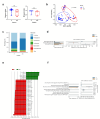Multi-omics analysis reveals the interplay between intratumoral bacteria and glioma
- PMID: 39660865
- PMCID: PMC11748541
- DOI: 10.1128/msystems.00457-24
Multi-omics analysis reveals the interplay between intratumoral bacteria and glioma
Abstract
Emerging evidence highlights the potential impact of intratumoral microbiota on cancer. However, the microbial composition and function in glioma remains elusive. Consequently, our study aimed to investigate the microbial community composition in glioma tissues and elucidate its role in glioma development. We parallelly performed microbial profiling, transcriptome sequencing, and metabolomics detection on tumor and adjacent normal brain tissues obtained from 50 glioma patients. We employed immunohistochemistry, multicolor immunofluorescence, and fluorescence in situ hybridization (FISH) staining to observe the presence and location of bacteria. Furthermore, an animal model was employed to validate the impact of key bacteria on glioma development. Six genera were found to be significantly enriched in glioma tissues compared to adjacent normal brain tissues, including Fusobacterium, Longibaculum, Intestinimonas, Pasteurella, Limosilactobacillus, and Arthrobacter. Both bacterial RNA and lipopolysaccharides (LPS) were observed in glioma tissues. Integrated microbiomics, transcriptomics, and metabolomics revealed that genes associated with intratumoral microbes were enriched in multiple synapse-associated pathways and that metabolites associated with intratumoral microbes were (R)-N-methylsalsolinol, N-acetylaspartylglutamic acid, and N-acetyl-l-aspartic acid. Further mediation analysis suggested that the intratumoral microbiome may affect the expression of neuron-related genes through bacteria-associated metabolites. In addition, both in vivo and in vitro models of glioma show that Fusobacterium nucleatum promotes glioma proliferation and upregulates CCL2, CXCL1, and CXCL2 levels. Our findings shed light on the intricate interplay between intratumoral bacteria and glioma.
Importance: Our study adopted a multi-omics approach to unravel the impact of intratumoral microbes on neuron-related gene expression through bacteria-associated metabolites. Importantly, we found bacterial RNA and LPS signals within glioma tissues, which were traditionally considered sterile. We identified key microbiota within glioma tissues, including Fusobacterium nucleatum (Fn). Through in vivo and in vitro experiments, we identified the crucial role of Fn in promoting glioma progression, suggesting that Fn could be a potential diagnostic and therapeutic target for glioma patients. These findings offer valuable insights into the intricate interplay between intratumoral bacteria and glioma, offering novel inspiration to the realm of glioma biology.
Keywords: Fusobacterium nucleatum; glioma; intratumoral microbiota; metabolomics; multi-omics.
Conflict of interest statement
The authors declare no conflict of interest.
Figures








References
-
- Jin C, Lagoudas GK, Zhao C, Bullman S, Bhutkar A, Hu B, Ameh S, Sandel D, Liang XS, Mazzilli S, Whary MT, Meyerson M, Germain R, Blainey PC, Fox JG, Jacks T. 2019. Commensal microbiota promote lung cancer development via γδ T cells. Cell 176:998–1013. doi:10.1016/j.cell.2018.12.040 - DOI - PMC - PubMed
-
- Qiao H, Tan X-R, Li H, Li J-Y, Chen X-Z, Li Y-Q, Li W-F, Tang L-L, Zhou G-Q, Zhang Y, Liang Y-L, He Q-M, Zhao Y, Huang S-Y, Gong S, Li Q, Ye M-L, Chen K-L, Sun Y, Ma J, Liu N. 2022. Association of intratumoral microbiota with prognosis in patients with nasopharyngeal carcinoma from 2 hospitals in China. JAMA Oncol 8:1301–1309. doi:10.1001/jamaoncol.2022.2810 - DOI - PMC - PubMed
MeSH terms
Grants and funding
LinkOut - more resources
Full Text Sources
Medical
Molecular Biology Databases
Miscellaneous
